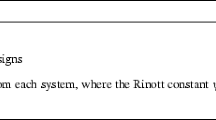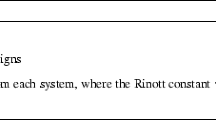Abstract
This article investigates simulation-based optimization problems with a stochastic objective function, stochastic output constraints, and deterministic input constraints. More specifically, it generalizes classic response surface methodology (RSM) to account for these constraints. This Generalized RSM—abbreviated to GRSM—generalizes the estimated steepest descent—used in classic RSM—applying ideas from interior point methods, especially affine scaling. This new search direction is scale independent, which is important for practitioners because it avoids some numerical complications and problems commonly encountered. Furthermore, the article derives a heuristic that uses this search direction iteratively. This heuristic is intended for problems in which simulation runs are expensive, so that the search needs to reach a neighbourhood of the true optimum quickly. The new heuristic is compared with OptQuest, which is the most popular heuristic available with several simulation software packages. Numerical illustrations give encouraging results.






Similar content being viewed by others
References
Angün E (2004). Black box simulation optimization: Generalized response surface methodology. PhD thesis, Tilburg University, Tilburg, Netherlands.
Barnes ER (1986). A variation on Karmarkar's algorithm for solving linear programming problems. Math Program 36: 174–182.
Ben-Gal I and Bukchin J (2002). The ergonomic design of working environment via rapid prototyping tools and design of experiments. IIE Trans 34(4): 375–391.
Bettonvil B and Kleijnen JPC (1996). Searching for important factors in simulation models with many factors: sequential bifurcation. Eur J Opl Res 96: 180–194.
Bettonvil B, del Castilllo E and Kleijnen JPC (2008). Statistical testing of optimality conditions in multiresponse simulation-based optimization. Working Paper, Tilburg University, Tilburg, Netherlands.
Booker AJ, Dennis JE Jr., Frank PD, Serafini DB, Torczon V and Trosset MW (1999). A rigorous framework for optimization of expensive functions by surrogates. Struct Optim 17(1): 1–13.
Del Castillo E and Montgomery DC (1993). Nonlinear programming solution to the dual response problem. J Qual Technol 25(3): 199–204.
Den Hertog D and Stehouwer HP (2002). Optimizing color picture tubes by high-cost nonlinear programming. Eur J Opl Res 140(2): 197–211.
Derringer G and Suich R (1980). Simultaneous optimization of several response variables. J Qual Technol 12: 214–219.
Efron B and Tibshirani RJ (1993). An Introduction to the Bootstrap. Chapman & Hall: New York.
Fan SK and Del Castillo E (1999). Calculation of an optimal region of operation for dual response systems fitted from experimental data. J Opl Res Soc 50(8): 826–836.
Fu MC (2002). Optimization for simulation: theory vs. practice. INFORMS J Comput 14(3): 192–215.
Glasserman P (1991). Gradient Estimation via Perturbation Analysis. Kluwer Academic: Dordrecht.
Harrington EC (1965). The desirability function. Ind Qual Control 21: 494–498.
Helton JC, Anderson DR, Marietta MG and Rechard RP (1997). Performance assessment for the waste isolation pilot plant: From regulation to calculation for 40 CFR 191.13. Opns Res 45(2): 157–177.
Ho YC and Cao XR (1991). Perturbation Analysis of Discrete Event Dynamic Systems. Kluwer Academic: Dordrecht.
Irizarry M, Wilson JR and Trevino J (2001). A flexible simulation tool for manufacturing-cell design, II: Response surface analysis and case study. IIE Trans 33: 837–846.
Kelton WD, Sadowski RP and Sadowski DA (2002). Simulation with Arena, 2nd edn.. McGraw-Hill: Boston.
Khuri AI (1996). Multiresponse surface methodology. In: Ghosh S. and Rao C.R. (eds). Handbook of Statistics Vol. 13. Elsevier: Amsterdam.
Khuri AI and Conlon M (1981). Simultaneous optimization of multiple responses represented by polynomial regression functions. Technometrics 23(4): 363–375.
Khuri AI and Cornell JA (1996). Response Surfaces: Design and Analysis, 2nd edn.. Marcel Dekker: New York.
Kleijnen JPC (1987). Statistical Tools for Simulation Practitioners. Marcel Dekker: New York.
Kleijnen JPC (2008a). Design and Analysis of Simulation Experiments. Springer Science+Business Media: New York.
Kleijnen JPC (2008b). Simulation experiments in practice: Statistical design and regression analysis. J Simul 2(1): 19–27.
Kleijnen JPC (2008c). Response surface methodology for constrained simulation optimization: An overview. Simul Model Pract Theory 16: 50–64.
Kleijnen JPC, van Beers W and van Nieuwenhuyse I (2008). Constrained optimization in simulation: A novel approach. Working Paper, Tilburg University, Tilburg, Netherlands.
Law AM (2007). Simulation Modeling and Analysis, 4th edn.. McGraw-Hill: Boston.
Myers RH and Carter WH (1973). Response surface techniques for dual response systems. Technometrics 15: 301–317.
Myers RH and Montgomery DC (2002). Response Surface Methodology: Process and Product Optimization Using Designed Experiments, 2nd edn.. Wiley: New York.
Rao CR (1967). Least squares theory using an estimated dispersion matrix and its application to measurement of signals. In: Le Cam L.M. and Neyman J. (eds). Proceedings of the Fifth Berkeley Symposium on Mathematical Statistics and Probability Vol. I. University of California Press: Berkeley, pp. 355–372.
Rubinstein RY and Kroese DP (2004). The Cross-Entropy Method: A Unified Approach to Combinatorial Optimization, Monte-Carlo Simulation and Machine Learning. Springer: New York.
Rubinstein RY and Shapiro A (1993). Discrete Event Systems: Sensitivity Analysis and Stochastic Optimization by the Score Function Method. Wiley: Chichester.
Ruud PA (2000). An Introduction to Classical Econometric Theory. Oxford University Press: New York.
Simpson TW, Booker AJ, Ghosh D, Giunta AA, Koch PN and Yang R-J (2004). Approximation methods in multidisciplinary analysis and optimization: A panel discussion. Struct Multidisc Optim 27(5): 302–313.
Spall JC (2003). Introduction to Stochastic Search and Optimization: Estimation, Simulation, and Control. Wiley: Hoboken, NJ.
Tekin E and Sabuncuoglu I (2004). Simulation optimization: A comprehensive review on theory and applications. IIE Trans 36: 1067–1081.
Vining GG and Myers RH (1990). Combining Taguchi and response surface philosophies: A dual response approach. J Qual Technol 22(1): 38–45.
Vonk Noordegraaf A, Nielen M and Kleijnen JPC (2003). Sensitivity analysis by experimental design and metamodelling: Case study on simulation in national animal disease control. Eur J Opl Res 146(3): 433–443.
Wei CJ, Olson DL and White EM (1990). Simultaneous optimization in process quality control via prediction-interval constrained programming. J Opl Res Soc 41(12): 1161–1167.
Yang T and Tseng L (2002). Solving a multi-objective simulation model using a hybrid response surface method and lexicographical goal programming approach: A case study on integrated circuit ink-marking machines. J Opl Res Soc 53(2): 211–221.
Ye Y (1989). An extension of Karmarkar's algorithm and the trust region method for quadratic programming. In: Megiddo N. (ed). Progress in Mathematical Programming: Interior-Point and Related Methods. Springer-Verlag: New York, pp. 49–63.
Author information
Authors and Affiliations
Corresponding author
Rights and permissions
About this article
Cite this article
Angün, E., Kleijnen, J., den Hertog, D. et al. Response surface methodology with stochastic constraints for expensive simulation. J Oper Res Soc 60, 735–746 (2009). https://doi.org/10.1057/palgrave.jors.2602614
Received:
Accepted:
Published:
Issue Date:
DOI: https://doi.org/10.1057/palgrave.jors.2602614




